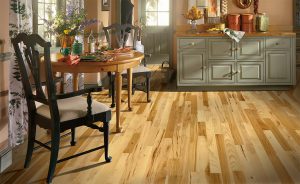Hickory floor is known for its toughness, visual variety, and traditional charm. It stands out as a popular choice among homeowners who want both durability and style. Its bold grain patterns and strong performance under stress make it ideal for active households and high-traffic areas.

Material Characteristics
Hickory is one of the hardest domestic woods available. It is harder than oak and maple, which gives it an edge in wear resistance and impact performance. Its appearance is also notable—contrasting tones of dark and light streaks naturally occur, offering a rustic yet dynamic aesthetic.
Durability
Hickory rates high on the Janka hardness scale, which measures wood’s resistance to dents and wear. This makes it ideal for homes with children, pets, or high levels of foot traffic. It handles daily use well and maintains its structure over time.
Color Variation
Unlike more uniform woods, hickory has a wide spectrum of colors within a single board. It ranges from creamy white sapwood to deep brown heartwood, giving each floor a one-of-a-kind look. This variation is appealing in rustic, farmhouse, or eclectic interior styles.
Installation Considerations
Due to its density and grain structure, installing hickory flooring can be more challenging than softer woods. Attention to detail and proper acclimation are critical to long-term performance.
Acclimation Time
Hickory should be acclimated in the space where it will be installed for at least 5–7 days. This helps prevent warping or gapping after installation, especially in climates with extreme humidity shifts.
Installation Method
Hickory can be nailed, stapled, or glued down depending on the product type. Engineered hickory allows for more flexible installation methods, including floating floors for areas with subfloor challenges. Due to its hardness, pre-drilling may be required to avoid splitting during nailing.
Maintenance and Longevity
Proper care can extend the life and beauty of a hickory floor for decades. While it’s low-maintenance compared to softer woods, a few best practices should be followed.
Daily Cleaning
Regular sweeping or vacuuming keeps debris from scratching the surface. Avoid using wet mops or steam cleaners, as excess moisture can damage the finish or cause the planks to expand.
Protective Measures
Use area rugs in high-traffic spots and felt pads on furniture legs. Keep indoor humidity between 30–50% to prevent seasonal movement. A polyurethane finish adds a layer of protection against spills and minor dents.
Design Flexibility
Hickory’s strong character works across various design themes, from traditional to modern. Its unique patterns and color contrast make it a statement piece in any room.
Rustic and Farmhouse Interiors
The natural variation in hickory enhances a rustic look. Wide plank formats amplify the organic beauty, especially when paired with distressed finishes and matte sealants.
Modern and Industrial Designs
While typically associated with classic interiors, hickory can also support bold, modern styles. When paired with neutral furniture and minimalistic decor, its bold grains create visual interest without overwhelming the space.




